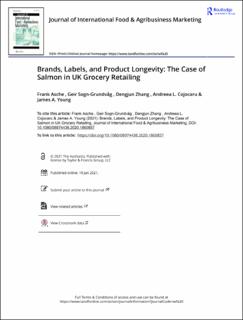| dc.contributor.author | Asche, Frank | |
| dc.contributor.author | Sogn-Grundvåg, Geir | |
| dc.contributor.author | Zhang, Dengjun | |
| dc.contributor.author | Cojocaru, Andreea-Laura | |
| dc.contributor.author | Young, James A. | |
| dc.date.accessioned | 2021-04-28T14:00:08Z | |
| dc.date.available | 2021-04-28T14:00:08Z | |
| dc.date.created | 2021-01-22T09:16:33Z | |
| dc.date.issued | 2021-01 | |
| dc.identifier.citation | Asche, F., Sogn-Grundvåg, G., Zhang, D. et al. (2021) Journal of International Food & Agribusiness Marketing, 33(1), 1-16. | en_US |
| dc.identifier.issn | 0897-4438 | |
| dc.identifier.uri | https://hdl.handle.net/11250/2740230 | |
| dc.description.abstract | In recent years, the number of ecolabels and country-of-origin labels has grown substantially in seafood markets globally. This makes it more difficult for retailers and producers to communicate and demonstrate their differentiating claims to consumers. In addition, it has recently been suggested that there are both costs and supply chain benefits associated with labeling. This paper uses duration analysis to investigate factors that influence product longevity for salmon in grocery retailing. Product longevity influences cost as a prolonged product lifetime reduces costs related to product development and marketing. As has been found for wild-caught whitefish, different retail chains appear to vary in their product labeling strategies. However, in contrast to wild fish, farmed salmon with ecolabels or domestic country-of-origin labels appear to have shorter product life cycles compared to products without ecolabels or with foreign country-of-origin labeling. This is most likely due to the higher control of the production process found in aquaculture. | en_US |
| dc.language.iso | eng | en_US |
| dc.publisher | Informa UK Ltd. (Taylor & Francis) | en_US |
| dc.rights | Navngivelse 4.0 Internasjonal | * |
| dc.rights.uri | http://creativecommons.org/licenses/by/4.0/deed.no | * |
| dc.subject | økonomi | en_US |
| dc.subject | laks | en_US |
| dc.subject | sjømat | en_US |
| dc.title | Brands, Labels, and Product Longevity: The Case of Salmon in UK Grocery Retailing | en_US |
| dc.type | Peer reviewed | en_US |
| dc.type | Journal article | en_US |
| dc.description.version | publishedVersion | en_US |
| dc.rights.holder | © 2021 The Author(s) | en_US |
| dc.subject.nsi | VDP::Samfunnsvitenskap: 200::Økonomi: 210::Bedriftsøkonomi: 213 | en_US |
| dc.source.pagenumber | 1-16 | en_US |
| dc.source.volume | 33 | en_US |
| dc.source.journal | Journal of International Food & Agribusiness Marketing | en_US |
| dc.source.issue | 1 | en_US |
| dc.identifier.doi | 10.1080/08974438.2020.1860857 | |
| dc.identifier.cristin | 1876920 | |
| dc.relation.project | Norges forskningsråd: 281040 | en_US |
| dc.relation.project | Norges forskningsråd: 295114 | en_US |
| cristin.ispublished | true | |
| cristin.fulltext | original | |
| cristin.qualitycode | 1 | |

